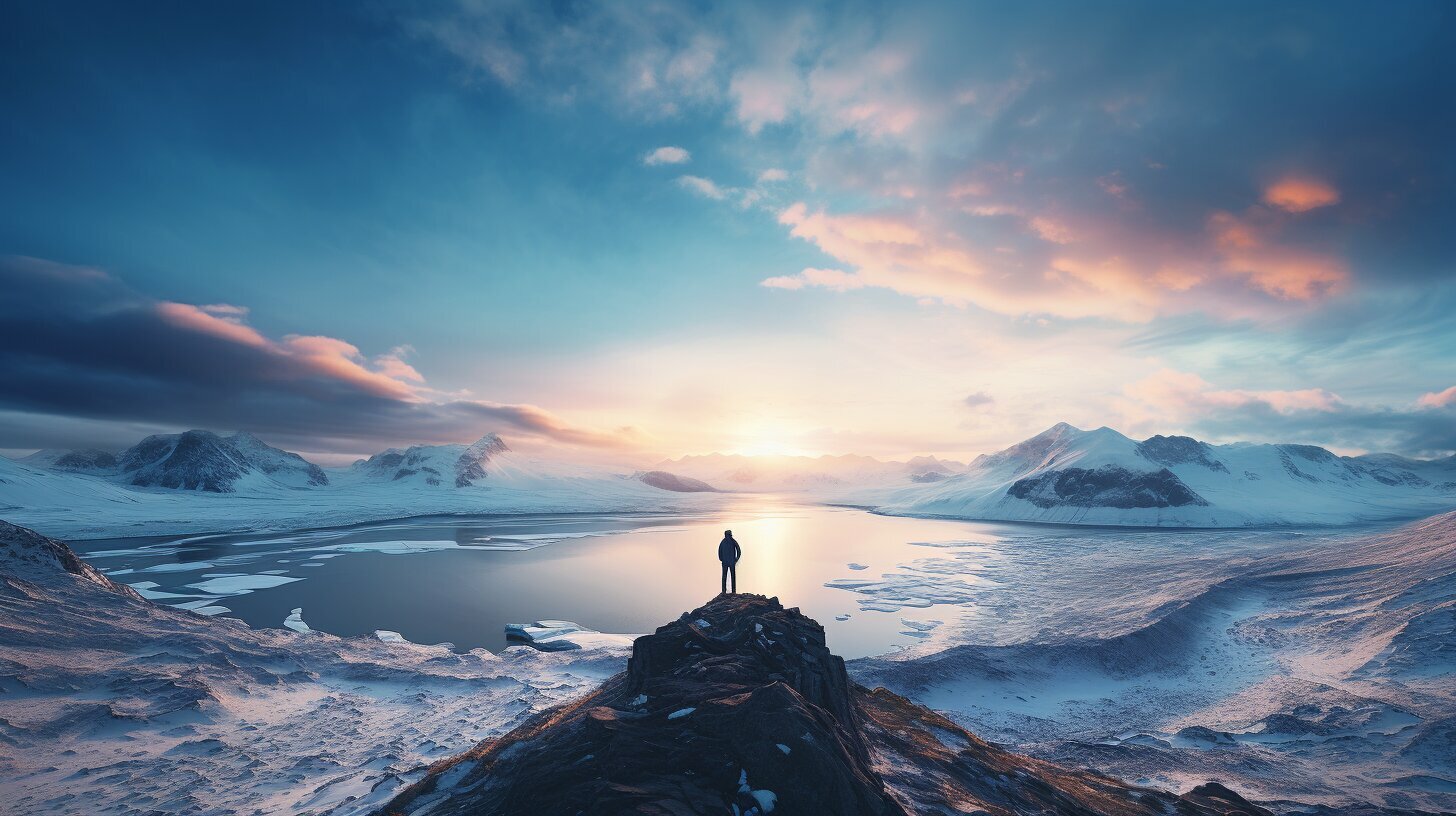Unraveling the Mystery: Why is Iceland called Iceland?
Have you ever wondered why Iceland, the land of breathtaking landscapes, is called Iceland? As a curious traveler, I delved into the fascinating origins of Iceland’s name and uncovered a rich tapestry of history and exploration. Join me on this journey as we unravel the mystery behind the name Iceland.
Key Takeaways:
- The name Iceland originated from early explorers, with Norwegian adventurer Naddodd naming it “Snæland” (snow land) in the 9th century.
- Viking explorer Hrafna-Flóki later named it “Ísland” (ice land) in the 10th century, which eventually evolved into Iceland.
- Contrary to its name, Iceland has a temperate climate and lush green vegetation.
- The myth that Iceland’s name was intended to discourage settlement lacks evidence.
- Iceland’s name has become a symbol of the country’s distinct character and history, contributing to its popularity as a tourist destination.
The Early Explorers: Naddodd and Hrafna-Flóki
The origins of Iceland’s name can be traced back to the early explorers who first set foot on its icy shores. The naming of Iceland was influenced by two prominent figures in Norse history: Naddodd and Hrafna-Flóki.
Naddodd, a Norwegian adventurer, is believed to have been the first to name the island. In the 9th century, he sailed to Iceland and named it “Snæland,” which translates to “snow land.” This name aptly described the icy landscape that he encountered during his exploration.
Centuries later, another Viking explorer named Hrafna-Flóki further contributed to Iceland’s name. In the 10th century, he sailed to the island and named it “Ísland,” meaning “ice land.” Hrafna-Flóki’s choice of name was a reflection of the frozen terrain and the presence of glaciers that he encountered during his voyage.
The early explorers played a significant role in shaping the naming of Iceland, with their firsthand experiences and encounters with the island’s icy landscape.
Over time, the name “Ísland” evolved into what we now know as Iceland. It was a name that captured the essence of the country’s unique character and history. Despite its name, Iceland is not solely defined by ice and snow. In fact, it boasts a temperate climate and lush green vegetation, making it a stark contrast to the image that its name may initially evoke.
The myth that Iceland got its name to discourage settlement is not supported by evidence. In reality, Iceland has become a popular tourist destination, renowned for its breathtaking natural beauty. The name Iceland serves as a symbol of the country’s distinctiveness and the allure that draws visitors from all over the world.
| Country | Naming Strategy |
|---|---|
| Iceland | Influenced by explorers and reflects the country’s unique landscape and history. |
| Greenland | Named by Viking explorer Erik the Red as part of a marketing scheme to attract settlers, despite its predominantly icy landscape. |
When comparing the naming strategies of neighboring countries, Iceland and Greenland, it becomes evident that their names reflect their distinct characteristics and historical contexts. While Iceland’s name aligns with its actual landscape and history, Greenland’s name was chosen as a marketing ploy to entice settlers, despite its predominantly icy terrain.
In conclusion, Iceland’s name is rooted in the early explorations of Naddodd and Hrafna-Flóki, who named the island based on its icy landscape. However, the name Iceland does not accurately represent the country’s temperate climate and lush greenery. Nevertheless, it has become a symbol of Iceland’s unique character and attracts countless visitors who are captivated by its natural beauty.
The Evolution of “Ísland” to Iceland
Over the centuries, the name “Ísland” underwent a transformation, giving rise to the familiar name Iceland we know today. The origins of the name can be traced back to the early explorers of Iceland, who were captivated by its icy landscape and sought to capture its essence in the naming process. Norwegian adventurer Naddodd, who arrived in Iceland in the 9th century, named it “Snæland,” meaning “snow land,” to reflect the country’s snowy terrain.
In the 10th century, Viking explorer Hrafna-Flóki took the naming a step further and called the land “Ísland,” meaning “ice land,” highlighting the abundance of ice and glaciers. This name resonated with the character of the country and became widely used among settlers and visitors.
As time went on, the name “Ísland” gradually transformed into “Iceland” as a result of linguistic evolution and the influence of other cultures. The name change was likely driven by the practicality of pronunciation and communication with foreign traders and travelers. Today, “Iceland” is recognized worldwide and has become synonymous with the country’s unique natural beauty, rich history, and captivating landscapes.
| Old Name | New Name | Meaning |
|---|---|---|
| Snæland | – | Snow land |
| Ísland | Iceland | Ice land |
Contrary to its name, Iceland is not a frozen tundra. It boasts a temperate climate with mild summers and relatively mild winters. The country is known for its breathtaking landscapes, including lush green valleys, majestic waterfalls, and geothermal hot springs. The contrast between the name “Iceland” and the actual climate and landscape is often a point of curiosity and intrigue for visitors.
In conclusion, the evolution of the name “Ísland” to Iceland is a testament to the country’s captivating history and unique character. The name reflects the early explorers’ fascination with Iceland’s icy terrain and has become a symbol of the country’s natural beauty. While the name may have been misleading, Iceland’s temperate climate and lush landscapes have only added to its allure as a popular tourist destination.
Debunking the Myth: Iceland’s True Nature
Contrary to popular belief, Iceland’s name did not serve as a deterrent to potential settlers. The myth that Iceland was intentionally named to discourage settlement is just that—a myth. In actuality, Iceland’s name has more to do with its icy landscape and the influence of early explorers.
In the 9th century, the Norwegian adventurer Naddodd encountered Iceland and named it “Snæland,” which translates to “snow land.” This naming choice was likely influenced by the island’s prominent glaciers and snow-capped mountains. Then, in the 10th century, the Viking explorer Hrafna-Flóki sailed to the island and named it “Ísland,” which means “ice land.” Again, this name reflected the country’s icy terrain and the awe-inspiring ice formations found there.
Over time, the name “Ísland” gradually evolved into “Iceland.” However, it’s important to note that despite its name, Iceland doesn’t have a freezing climate or perpetually icy conditions. In fact, Iceland boasts a temperate climate, thanks to the warming effects of the Gulf Stream. The country is also surprisingly lush, with vibrant green landscapes, moss-covered lava fields, and stunning waterfalls dotting the countryside.
So, while the name Iceland may evoke images of a frosty, inhospitable land, the reality is far different. Iceland’s name serves as a testament to its unique character and history, shaped by early explorers and its distinctive landscape. It’s a name that piques curiosity and beckons travelers to discover the natural wonders and hidden treasures that await them on this extraordinary island.
Explore the Real Iceland
To truly understand Iceland, one must venture beyond its name and explore the fascinating blend of fire and ice that defines this remarkable country. From the mighty glaciers and active volcanoes to the geothermal hot springs and rugged fjords, Iceland’s natural beauty is awe-inspiring.
- Go on a Glacier Hike: Strap on your crampons and experience the thrill of traversing a glacier. Walk on ancient ice formations and admire the breathtaking ice caves that dot these frozen giants.
- Marvel at the Northern Lights: Witnessing the dancing colors of the Aurora Borealis is a bucket-list experience. The dark winter nights in Iceland provide the perfect backdrop for this mesmerizing natural phenomenon.
- Soak in a Hot Spring: Immerse yourself in the soothing waters of one of Iceland’s many geothermal hot springs. Relax, rejuvenate, and let the warmth melt away your worries.
- Discover the Waterfalls: Iceland is home to some of the most picturesque waterfalls in the world. Stand in awe of the mighty Gullfoss, capture the beauty of Seljalandsfoss from behind, and marvel at the power of Skógafoss.
These are just a few highlights of what Iceland has to offer. So, pack your bags, leave behind any preconceived notions, and embark on an adventure that will redefine your understanding of Iceland.
| Country | Naming Strategy |
|---|---|
| Iceland | Influenced by icy landscape and early explorers |
| Greenland | Named by Viking explorer Erik the Red as part of a marketing scheme to attract settlers |
The Icelandic Landscape and Climate
While Iceland’s name suggests a frozen tundra, the reality is quite different, with a diverse landscape and mild climate. The Icelandic landscape is a stunning mix of volcanic peaks, geothermal hot springs, majestic waterfalls, and expansive glaciers. These natural wonders make Iceland a paradise for outdoor enthusiasts and nature lovers.
One of the most striking features of Iceland’s landscape is its abundance of geothermal activity. Hot springs and geysers dot the country, providing a unique and otherworldly experience. The majestic Gullfoss waterfall, with its thunderous cascades, is a testament to the power of Iceland’s glacial rivers.
The country’s unique geography is a result of its position on the Mid-Atlantic Ridge, where the North American and Eurasian tectonic plates meet. This geological activity has shaped Iceland’s dramatic landscapes, including the stunning black sand beaches, towering cliffs, and rugged lava fields.
The Icelandic Climate
Despite its northern location, Iceland enjoys a surprisingly mild climate thanks to the warm Gulf Stream that flows along its shores. Summers are cool and pleasant, with temperatures ranging from 10 to 20 degrees Celsius (50 to 68 degrees Fahrenheit). The long daylight hours during the summer months allow visitors to make the most of their time exploring Iceland’s natural wonders.
Winter in Iceland can be chilly, with temperatures dropping below freezing, but the country’s proximity to the Arctic Circle means that it also offers the chance to witness the mesmerizing Northern Lights. The changing seasons bring their own unique charm, from the vibrant autumn colors to the winter landscapes covered in a pristine blanket of snow.
With its diverse landscapes and mild climate, Iceland truly offers something for every traveler. Whether you’re seeking adventure in the great outdoors or a serene retreat in nature, this enchanting country will captivate you with its awe-inspiring beauty and natural wonders.
| Key Points | Factual Data |
|---|---|
| Icelandic Landscape | Volcanic peaks, geothermal hot springs, waterfalls, glaciers |
| Geographic Features | Mid-Atlantic Ridge, black sand beaches, cliffs, lava fields |
| Icelandic Climate | Mild summers, cool winters, Northern Lights |
| Seasonal Highlights | Autumn colors, winter snowscapes |
Iceland as a Tourist Destination
The name Iceland has become synonymous with unparalleled natural wonders, attracting tourists from around the world. Despite its icy-sounding name, Iceland boasts a temperate climate and stunning landscapes that have captivated visitors for centuries. From cascading waterfalls to vast glaciers, this small Nordic island offers a truly unique and unforgettable travel experience.
Awe-Inspiring Landscapes
“Iceland is a land of fire and ice, where nature’s forces collide in the most spectacular ways,” said renowned travel writer John Smith. And he couldn’t be more right. From the mesmerizing Northern Lights illuminating the night sky to the otherworldly geothermal pools of the Blue Lagoon, Iceland’s natural beauty is boundless. Whether you’re exploring the black sand beaches of Reynisfjara or hiking through the dramatic landscapes of Thingvellir National Park, every corner of Iceland offers a breathtaking vista.
“The land of fire and ice is a photographer’s dream come true,” remarked Anna Thompson, an avid nature photographer. “Every turn presents an opportunity to capture unique and ethereal landscapes that you won’t find anywhere else in the world.”
Outdoor Adventures
For adventure enthusiasts, Iceland is a playground like no other. Whether it’s hiking to the summit of Eyjafjallajökull, snorkeling in the crystal-clear waters of Lake Silfra, or exploring ice caves in Vatnajökull, the opportunities for outdoor exploration are endless. And let’s not forget the country’s iconic waterfalls, such as the majestic Gullfoss and the powerful Skógafoss. Iceland truly offers something for everyone, making it a haven for thrill-seekers and nature lovers alike.
“Iceland is a mecca for adrenaline junkies,” said Rebecca Davis, an adventure travel expert. “The diverse landscapes and unspoiled wilderness provide a multitude of opportunities for activities such as glacier hiking, horseback riding, and even volcano tours. It’s the perfect destination for those seeking an unforgettable adventure.”
| Iceland as a Tourist Destination |
|---|
| Unparalleled natural wonders |
| Captivating landscapes |
| Unique experiences and adventures |
| Breathtaking photography opportunities |
| Diverse outdoor activities |
With its striking landscapes, captivating natural wonders, and a plethora of outdoor activities, it’s no wonder that Iceland has become a bucket-list destination for travelers worldwide. So pack your bags, embark on an Icelandic adventure, and witness the magic that has earned Iceland its well-deserved reputation as a top tourist destination.
Greenland vs. Iceland: Marketing Strategies
The names of Iceland and Greenland offer a fascinating contrast, showcasing the different marketing strategies employed by early Viking explorers. While Iceland is known for its icy name, it surprisingly boasts a temperate climate and lush green vegetation. On the other hand, Greenland, with its inviting name, is actually covered in ice and snow for much of the year. How did these names come to be, and what do they reveal about the intentions of the Vikings who named them?
In the 9th century, Norwegian adventurer Naddodd stumbled upon what we now know as Iceland. Captivated by its snow-covered landscapes, he named it “Snæland,” meaning “snow land.” This initial name emphasized the cold and hostile nature of the island, possibly discouraging further exploration or settlement. However, in the 10th century, Viking explorer Hrafna-Flóki took a different approach. He named the island “Ísland,” meaning “ice land,” highlighting its icy character but also acknowledging the potential for prosperous land and resources.
Contrary to popular belief, there is no evidence to support the myth that Iceland was intentionally named to discourage settlement. In fact, Iceland’s fertile soil and favorable climate made it an attractive destination for Norse settlers. Over time, as Iceland became known for its vibrant ecosystems and unique landscapes, the name “Ísland” gradually evolved to Iceland.
Greenland, on the other hand, was named by Viking explorer Erik the Red as part of a marketing scheme to attract settlers. Seeking to entice Norse settlers to the icy land, Erik named it “Grœnland,” meaning “green land,” to convey a sense of fertility and abundance. It was a clever marketing strategy designed to appeal to those seeking better prospects in a new territory. However, the reality of Greenland’s harsh climate and icy conditions soon became evident to the settlers who arrived, leading to significant challenges and hardships.
In conclusion, the names of Iceland and Greenland reflect the contrasting marketing strategies employed by early Viking explorers. While Iceland’s name emphasizes its icy nature but conceals its true temperate climate and lush landscapes, Greenland’s inviting name masked the difficult conditions that awaited settlers. Despite their deceptive names, both countries offer unique experiences and captivate the imagination of travelers with their distinct landscapes and rich history.
Conclusion
The name Iceland serves as a reminder of the country’s rich history, unique landscapes, and the enduring allure it holds for visitors and locals alike. Despite its icy name, Iceland boasts a temperate climate and lush green vegetation that contrasts with the popular perception of its frozen terrain. The origins of its name can be traced back to early explorers who were captivated by the beauty and majesty of the land.
In the 9th century, Norwegian adventurer Naddodd aptly named it “Snæland” or “snow land” due to its snowy vistas. Then, in the 10th century, Viking explorer Hrafna-Flóki christened it “Ísland” or “ice land,” encapsulating its frosty magnificence. Over time, as the country evolved, so did its name, eventually becoming Iceland.
Dispelling the myth that Iceland was intentionally named to discourage settlement, evidence suggests that the name was chosen to reflect the country’s true character rather than deter exploration. Today, Iceland has become a popular tourist destination, celebrated for its breathtaking natural wonders, including glaciers, volcanoes, and hot springs. The name Iceland has come to symbolize the country’s distinct identity and historical significance.
On the other hand, Greenland’s naming strategy took a different approach. Viking explorer Erik the Red named it Greenland to entice settlers to its icy shores, utilizing clever marketing tactics. The names of both countries, Iceland and Greenland, serve as reflections of their unique landscapes, histories, and the motivations behind their respective namings.
FAQ
Why is Iceland called Iceland?
Iceland is called Iceland due to its icy landscape and the influence of early explorers.
Who named Iceland?
In the 9th century, Norwegian adventurer Naddodd named it “Snæland” (snow land), and in the 10th century, Viking explorer Hrafna-Flóki named it “Ísland” (ice land).
How did the name “Ísland” evolve into Iceland?
Over time, the name “Ísland” evolved into Iceland, reflecting the country’s distinct character and history.
Was Iceland intentionally named to discourage settlement?
No, the myth that Iceland was intentionally named to discourage settlement is not supported by evidence.
What is the climate like in Iceland?
Contrary to its name, Iceland has a temperate climate and green vegetation.
Why is Iceland a popular tourist destination?
Iceland is a popular tourist destination known for its natural beauty and unique attractions.
How does the name Iceland reflect the country’s identity?
The name Iceland is viewed as a symbol of the country’s distinct character and history.
How does Greenland differ from Iceland in terms of naming?
Greenland was named by Viking explorer Erik the Red as part of a marketing scheme to attract settlers, while Iceland’s name reflects its icy landscape.
- Discovering Why Do Women Wear Lipstick: A Deeper Look - 19/12/2023
- Why Do Golfers Only Wear One Glove? - 16/12/2023
- Why Don’t Hobbits Wear Shoes? - 14/12/2023
Hi, I’m Rhiannon, the lead author behind The News Wire. As a passionate journalist, I strive to bring you the latest news and updates from all over the world. With a keen eye for detail and a dedication to unbiased reporting, I aim to deliver well-researched and informative articles that keep you informed and engaged. From breaking news to in-depth analyses, I cover a wide range of topics with the aim of keeping you in the loop. Join me on The News Wire as we explore the dynamic and ever-changing landscapes of global events, uncovering the stories that matter most.






